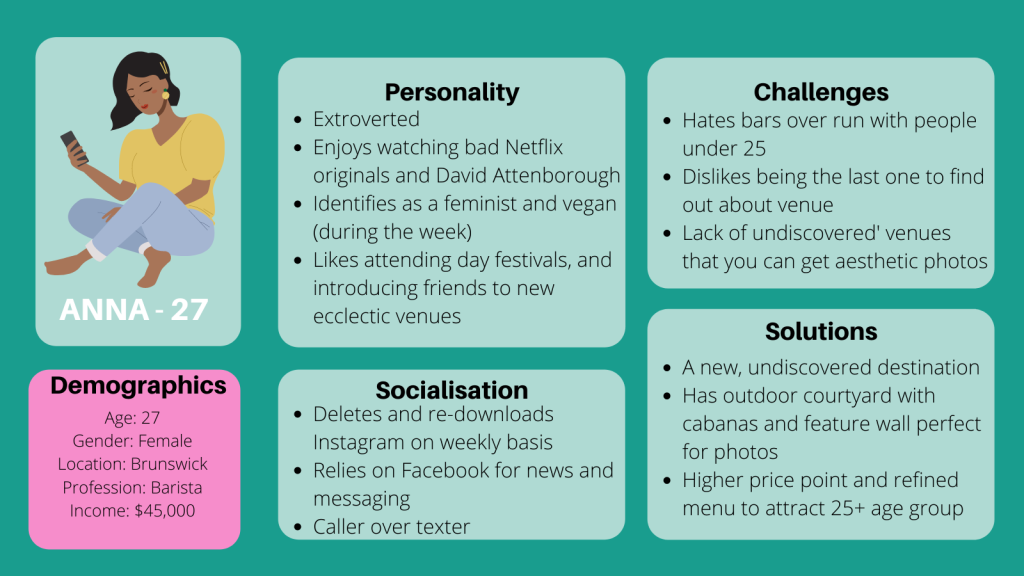Could you describe your key customer base down to their preferred coffee order?
What if we told you this was the secret ingredient to cut-through marketing?
Okay – we aren’t suggesting the key to a killer marketing plan is to undertake a mass stalking expedition. But there is value to be gleaned from having an accurately informed perception of who exactly is purchasing your product and service.
This is precisely why the most successful business rely on marketing personas to guide their marketing plans.

What is a Marketing Persona?
A marketing persona is representation of a chunk of your customers, boiled down to one fictional character.
Basically, you take a chunk of data about your audience, pull out some common themes and create a singular persona to represent that customer base.
There is a method to this madness.
Crafting dedicated market personas – or buyer personas, as they are sometimes referred to – will give you the ability to tailor your marketing efforts to solve the specific problems of your customers.
How to Create a Marketing Persona
Collect Data
The key to creating a beneficial marketing persona is to base it on your actual customer, not your ideal customer. This means accruing real data on your buyers rather than going off your gut instinct on who your buyer is.
You essentially want to find out everything you can about the people buying your product or service. From where they live to their daily irks, you’re about to deep dive into the psyche of your customer base.
Social media stalking extraordinaires unite – we’ve finally found our calling.
Thanks to the technology at hand today, acquiring these mounds of data has never been easier.
Here’s where you might begin the data scavenging hunt:
- Google Analytics
- Purchase details (eg. Shopify customer check out details, billing info)
- Talk to your sales team – get them to paint a picture of the type of leads they’re regularly interacting with
- Social media
- Product reviews
And we have one final avenue for data sourcing that is so important we are making it its own point – customer interviews.
Customer interviews are one of the most effective tools for gaining qualitative date about your customers. Begin by drawing up a list of questions that’ll help you uncover the When, Who, What, Where, Why and How your customer uses your product or service.
Analyse Data to Find Commonalities and Trends
Now that you’ve got hoards of data on your buyers, what do you do with it?
To make sense of it and pull out commonalities, you’re going to need to compile it into a sortable spreadsheet. This will help you identify recurring patterns or trends that will begin to form the skeleton of your marketing persona.
If you’re conducting a B2B marketing persona, you may begin by analysing the data at a macro level before moving to an individual level. Essentially, you pull out common industries, organisation sizes and net worth, before moving the seniority level and job title of the individual buyers.
Often graphs can be useful during this step to provide a visual representation of certain trends and frequencies.
Drafting Your Persona
We’re inching closer and closer to nailing down those ambiguous buyer profiles.
For this next step, it’s helpful to have a persona template to work with. These are simple to draw up and can then be populated with the data of each persona as you go.
The sections your persona pro forma may want to focus on may include:
- Demographics (age, gender, location, profession, income)
- Personality traits (introvert vs extrovert, interests, passions, alliances)
- Socialisation formats (keeps to self, heavy social media presence, texter vs caller)
- Challenges / problems (struggles this person faces when meeting goals)
- How can you help (what your company can do to alleviate these struggles)
Tip: some find it helpful to attach an image to each persona to act as a visual cue to keep the persona in mind.
Now you don’t need to create 56 personas for each buyer demographic. In fact, we find that the sweet spot is usually 3 – 6.
It’s time to breathe life into these personas. Populate your templates with the most abundant trends you’ve observed through your customer analysis.
Don’t forget to give your persona a name that reflects the personality you’ve profiled.
Here’s an example of how your completed marketing persona may look for a new Melbourne bar.

Put it Into Practice
Now that you have your Indiana the Insta-Affluent, Blake the Blasé Brickie, and Fiona the Fretful Finance Manager, it’s time to break the ice.
Getting social with your personas will require you to formulate key messaging, and a wider communications strategy targeted at each persona.
Think tone, distribution channels, visuals and the simple premise you want to convey to Indiana, Blake and Fiona. Basically, you should be able to finesse your message to each persona into a punchy elevator pitch. You can then expand upon this in your communications.
If you’re struggling to decipher your blasé brickie from your Instagram influencer, allow us to lend a helping hand. Wordly’s marketing department are aces at creating in-depth marketing personas that’ll project your key customers into the forefront of your every decision. Drop us a line to find out more.



